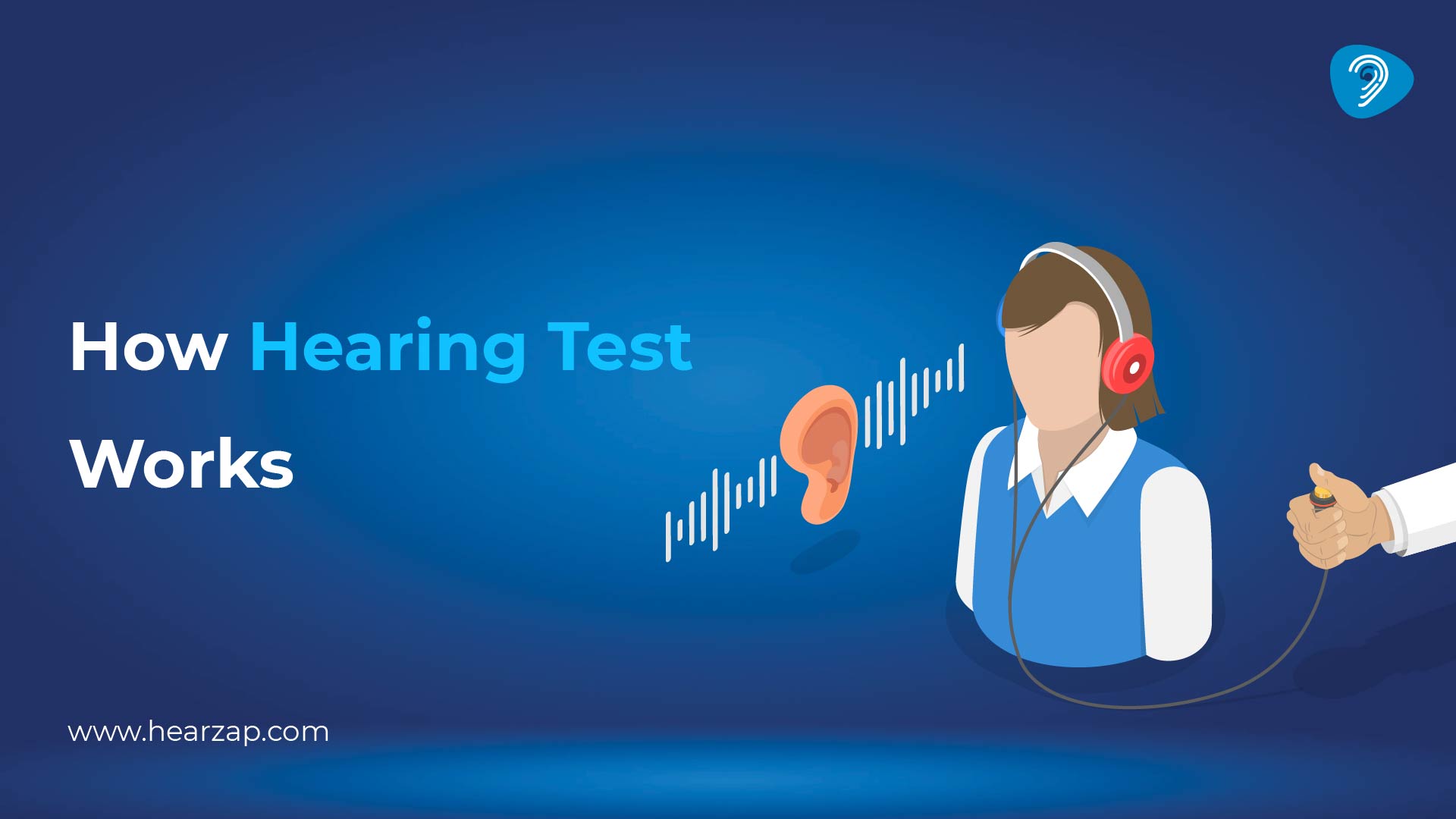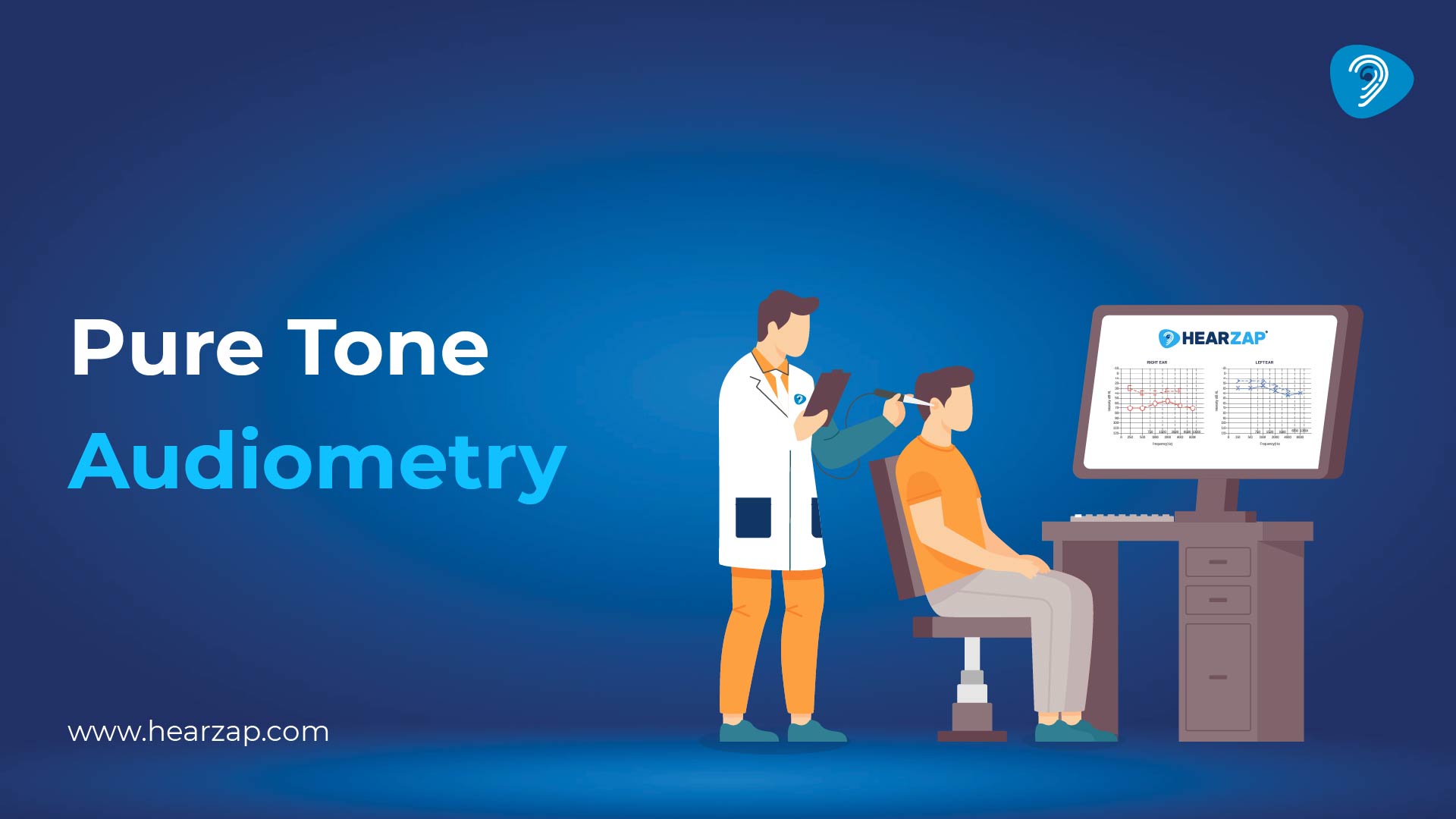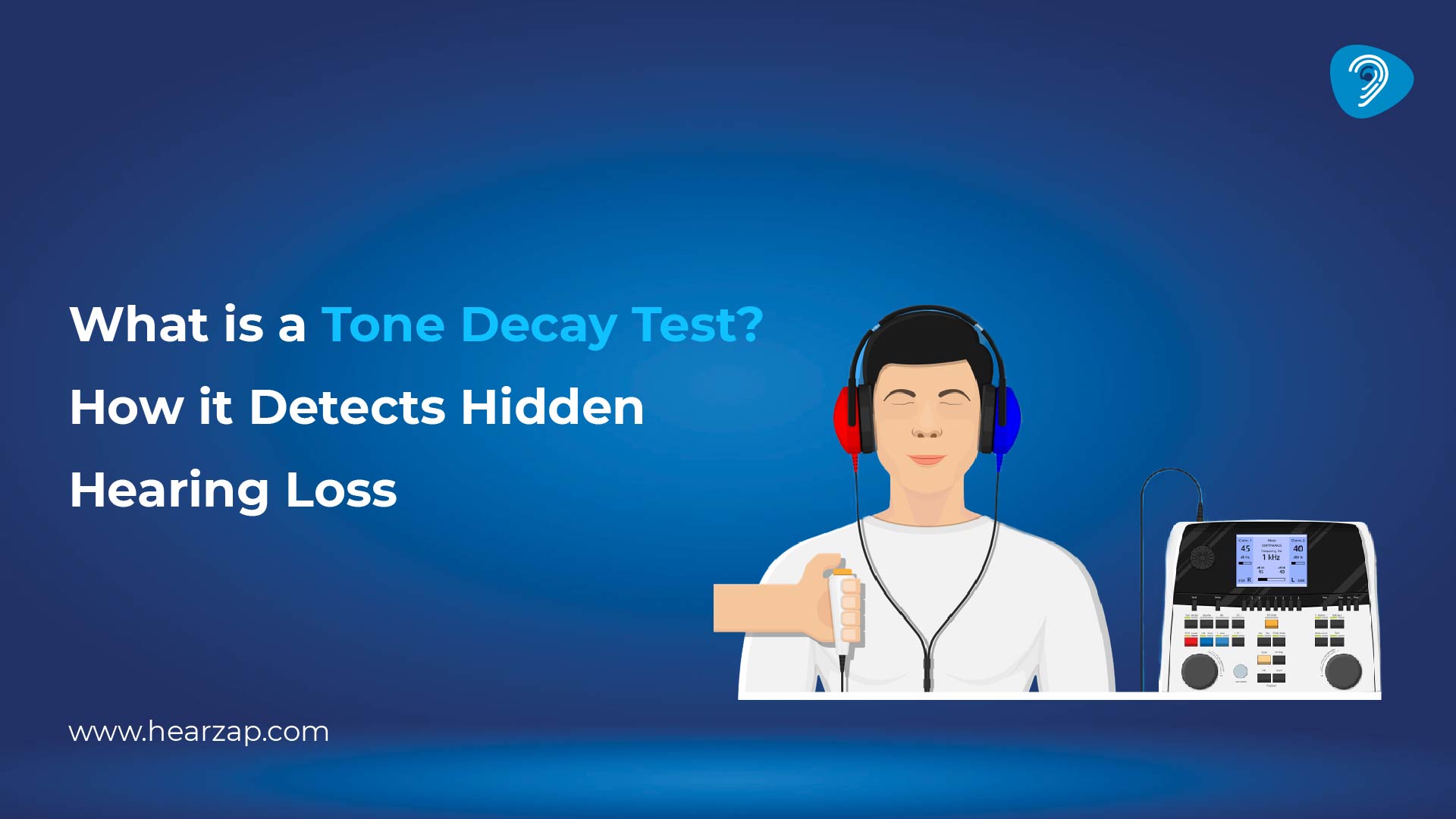HEARING TEST
What is a Hearing Test & How It Works
By Team Hearzap | Oct. 15, 2025

Ever missed a bell at the gate or nodded along in a team huddle because the words blurred together? That’s the moment most people start asking what is a hearing test and whether getting one would help. A hearing test is a quiet, structured check of how softly you hear sounds and how clearly you follow speech. It’s done in a sound-treated room, uses headphones and a few gentle probes, and it gives a practical picture of listening comfort and any early hearing loss, so chats at home, online classes, and office conversations feel easier.
What is a Hearing Test?
A hearing test isn’t a single pass/fail exam. Think of it as a small toolkit. At the centre is an audiometry test that maps the softest level you can notice at different pitches - from the low hum of a bus to the crisp hiss in “s” and “t”. Around that core are supporting checks that look at how the eardrum moves, how inner-ear hair cells behave, and how the hearing nerve carries signals. When professionals refer to the types of hearing tests, they mean this bundle working together rather than one lonely number.
Why test more than one thing? Because sound takes a longish route: canal → eardrum → three tiny bones → inner-ear fluid → microscopic hair cells → hearing nerve → brainstem.
If even one step underperforms, listening becomes tiring, especially in lively places like a café, a wedding sangeet, or a factory floor. A complete hearing test spots patterns so the clinician can explain what’s likely going on, what to watch, and what practical steps might help day to day.
How Does a Hearing Test Work?
A full appointment follows a predictable path: a short history and an ear look, measurements with tones, a check of speech clarity, and simple tests of middle- and inner-ear function. None of it is painful. You can ask for a pause at any time.
Initial Screening and Ear Exam
Things start with your story. Which ear feels different? Since when? Any ringing, dizziness, pain, or blocked feeling? Work and lifestyle matter in India - traffic duty, workshops, loud DJ nights, prolonged hours of earphone usage, or long scooter rides with earphones. Medicines are noted too because a few come with hearing-related cautions.
Next, the clinician uses an otoscope (a tiny torch) to inspect the ear canal and eardrum. Wax, infection, or a perforation is recorded; each of these can influence results. Some centres add quick tuning-fork checks (Rinne/Weber). Those are rough pointers only; the real detail arrives in the booth.
Pure Tone Testing
This is the heart of the audiometry test most people recognise. You sit in a quiet booth wearing headphones. Soft beeps of different pitches play, typically 250 to 8,000 Hz, one ear at a time. You press a button each time you hear a sound. The aim is to find the softest level you can hear at least half the time at each pitch. That procedure is pure tone testing (also known as pure tone audiometry).
Results are written in dB HL. A quick summary called the pure-tone average (usually the mean of 500, 1,000 and 2,000 Hz) helps describe speech audibility. Patterns matter:
- A downward slope (good lows, weaker highs) explains “I hear you, but words blur in noise.”
- A flat reduction can hint at a middle-ear issue.
- A notch around 4,000 Hz may appear after years of unprotected loud sound. Think workshops, band practice, or spirited DJ sets.
Your graph isn’t a verdict; it’s a map that guides the next conversation.
Bone Conduction Testing
Air-conduction results show the whole pathway. Bone conduction testing bypasses the outer and middle ear. A tiny vibrating tip sits on the mastoid bone behind the ear and sends sound directly to the inner ear. If bone thresholds are much better than air thresholds (often a gap of ~15 dB or more), a conductive element is suspected - earwax, fluid, or stiff middle-ear bones. If both air and bone are reduced and close together, the change likely lies in the inner ear or hearing nerve.
Think of two doors leading to the same hall. If the side door opens easily while the front door sticks, you know where the resistance sits. That’s the value of bone conduction testing.
Speech Testing
Real life is conversations, not beeps. Speech tests cover that reality:
- Speech Reception Threshold (SRT): the quietest level at which you can repeat simple two-syllable words. It usually lines up with the pure-tone average; when it does, everyone trusts the numbers a little more.
- Word Recognition / Discrimination: words are played at a comfortable volume and you repeat what you hear. The percentage correct shows how clearly you recognise speech once loud enough - very helpful for explaining why a classroom or a railway platform feels hard, even when tones look fine.
In India, many clinics keep word lists in English plus regional languages, so the test reflects the language you actually use at home or at work.
Tympanometry
The tympanometry test measures how the eardrum and middle ear move. A soft eartip seals the canal; the device gently changes air pressure while playing a steady tone and plots a curve called a tympanogram.
- Type A: normal mobility.
- Type As: shallow peak - suggests stiffness.
- Type Ad: very tall peak - indicates a very flexible eardrum, sometimes after a healed perforation.
- Type B: flat - often seen with fluid behind the eardrum or an open perforation.
- Type C: peak shifted to the negative side - common after a cold when the Eustachian tube feels blocked.
The test is quick and not painful. It’s especially useful for school-age children when “glue ear” is suspected.
Auditory Brainstem Response (ABR)
ABR checks how sound signals travel along the hearing nerve to the brainstem. Small sensors are placed on the forehead and near the ears. You relax while clicks or tone bursts play through earphones. A computer averages the tiny electrical responses and plots waves labelled I to V. ABR helps estimate hearing when button-press responses aren’t possible - newborns, very young children, or anyone who can’t give consistent responses- and it offers clues when speech clarity seems poorer than tone results suggest.
Otoacoustic Emissions (OAE)
The otoacoustic emissions test listens for faint echoes generated by the inner ear’s outer hair cells. A tiny probe sends soft sounds into the canal, and a sensitive microphone records the ear’s response. Present, repeatable emissions usually indicate healthy hair-cell activity. Absent emissions may reflect wax, middle-ear issues, inner-ear change, or simply too much background noise. OAEs are widely used in newborn screening across hospitals because the check is fast, gentle, and doesn’t require any button-pressing.
Results and Audiogram
All the readings come together on an audiogram - pitch on the x-axis, loudness on the y-axis. Right-ear air-conduction symbols are usually red circles; left-ear symbols, blue crosses. Bone-conduction symbols sit alongside, so the air–bone relationship is easy to see.
Typical interpretive ranges are:
- 0-20 dB HL: within normal limits
- 21-40 dB HL: mild hearing loss
- 41-55 dB HL: moderate
- 56-70 dB HL: moderately severe
- 71-90 dB HL: severe
- 90+ dB HL: profound
The shape matters as much as the numbers. A notch near 4,000 Hz often follows years of loud sound without protection. A flat loss plus a large air–bone gap points to a conductive element that may be temporary. A gentle high-frequency slope explains why soft consonants (“s”, “f”, “th”) go missing in noise. After testing, the discussion turns those squiggles into plain advice you can use, where to sit in meetings, how to manage restaurants, when to repeat a check, and what to do during festival season or at a worksite.
How to Prepare for a Hearing Test
Preparation is straightforward, but it improves reliability.
- Avoid loud sounds for 24 hours. Keep earphones modest. If you’re on site or near speakers, carry simple foam plugs.
- Note symptoms: which ear, when it started, ringing, dizziness, pain, discharge, or a sense of pressure.
- List medicines and health conditions; bring previous reports if you have them - trends over time tell the best story.
- Skip cotton buds if you suspect wax. They push wax deeper; let the clinic check and advise.
- For children, choose a time when they’re fed and rested; bring a small toy or book.
During the visit, expect 30-60 minutes, depending on which types of hearing tests are needed. Follow instructions, respond only when you are sure, and ask for a pause if something feels off. After the visit, review the audiogram, ask for clear takeaways you can apply to calls, classrooms, travel, and open-plan offices, and discuss common-sense protection for loud places.
Conclusion
Once you understand what is a hearing test, the whole process stops feeling mysterious. It isn’t a single pass–fail moment; it’s a tidy set of tools - pure tone testing, bone conduction testing, speech measures, the tympanometry test, ABR, and the otoacoustic emissions test - that together show how sound travels through your ears and how your brain makes sense of it. The result is practical: you know what’s happening, what to monitor, and how to make everyday listening a bit easier.
Book your hearing test today with Hearzap for expert care.
FAQs
What is a hearing test, and how does it work?
A hearing test is a bundle of checks that map the softest tones you detect and how clearly you follow words. The core audiometry test uses pure tone testing; bone conduction testing compares the direct inner-ear route with the air route; the tympanometry test looks at eardrum movement; and the otoacoustic emissions test plus ABR provide objective information about inner-ear and nerve function.
How long does a hearing test take?
A standard appointment usually finishes in 30-60 minutes, depending on your history and which types of hearing tests are chosen. ABR for infants or anyone unable to press a button may take longer because resting quietly gives cleaner readings.
Do I need to prepare for a hearing test?
Yes, though it’s simple: avoid very loud sounds for a day, note medicines and symptoms, and arrive rested. For children, pick a calm time and carry a small toy. If you suspect wax, avoid cotton buds and let the clinic examine and advise.
Is a hearing test painful?
No. Headphones and button presses are comfortable. The tympanometry test creates a gentle pressure change that can feel unusual but not painful. OAEs and ABR use soft eartips or small skin sensors and quiet listening.
How often should I have a hearing test?
Many adults like a baseline hearing test and then periodic checks - sooner if they notice changes, work in noise, or have ear-related conditions. The clinician will suggest an interval that suits your situation.
What problems can a hearing test detect?
Results can suggest conductive issues (wax, fluid, or eardrum changes), sensorineural changes in the inner ear or nerve, or a mix. They also explain speech-in-noise difficulty and help track changes over time so day-to-day strategies can be adjusted.
Related Blogs

Pure Tone Audiometry

What is a Tone Decay Test? How It Detects Hidden Hearing Loss
Contact us
We are here for all your hearing needs, from hearing tests to hearing aids. Fill out the form below, and we will give you a call soon.
Please enter a valid mobile number with 10 digits.
Recent Blogs
By None | Dec. 4, 2025
By None | Dec. 2, 2025
By None | Nov. 28, 2025
By None | Nov. 27, 2025
By None | Nov. 26, 2025









